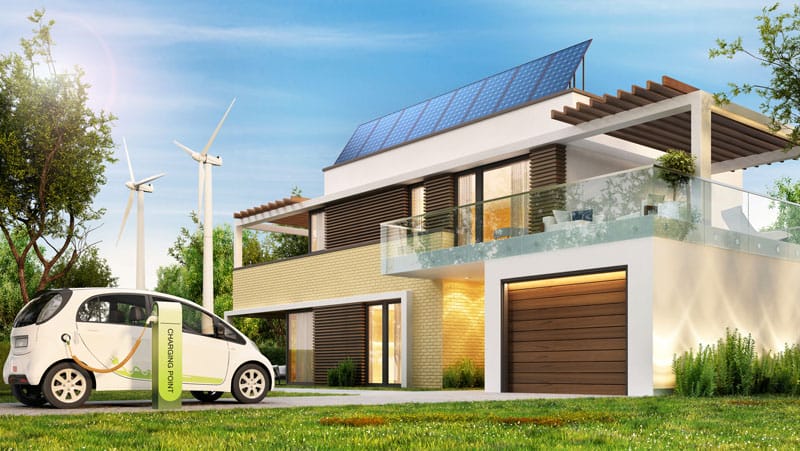Written by Cara Fitzgerald | 13 October 2023
As Australians, we are becoming increasingly climate conscious and environmentally aware. As homeowners, we face the escalating costs of living and running a household. Holding on to or acquiring the great Australian dream of home ownership means sustainable and energy efficient choices are now more of a necessity than an option.
Research shows that two-thirds of home buyers have a preference for energy efficient homes. Homes with energy efficient features have greater buyer interest and sell faster, according to the Domain Sustainability in Property Report 2022 .1
So, if you’re planning to sell in the near future, you will no doubt be considering which home improvements will increase the value of your property before the sale sign goes up. Follow our 7 suggestions for sustainable and energy efficient home improvements specifically tailored for the Australian climate that will earn you both short- and long-term benefits, from immediate savings of utility bills to a price premium when you sell.
7 Sustainable and Energy Efficient Home Improvements
Solar power savings: Harnessing the sun’s energy
Australia abounds with sunlight, making solar power both an expected inclusion and one that will definitely give your property the edge over those without. By powering your home from solar panels on your roof, you will not only reduce your reliance on fossil fuels, but you will also cut down your electricity bills over time. For even more benefit, consider adding a solar battery for maximum solar energy utilisation during peak demand periods.
Efficient windows: Creating natural light and insulation
Energy-efficient windows reflect heat in summer and keep warmth inside during winter, making them a worthwhile home improvement for older homes in order to regulate temperature and energy consumption. Double-glazed or low-emissivity (Low-E) windows are excellent options for Australian homes as they provide insulation and reduce the need for excessive heating or cooling, while allowing ample natural light to enter, reducing the reliance on artificial lighting.
Water conservation: Harvesting and reuse
Australians are one of the thirstiest nations in the world, drinking more than 100,000 litres of water per person, per year, and this is despite being one of the driest continents on the planets and prone to periodic droughts.2
Home improvements that reduce our demand on traditional water supply services, use less water and recycle our water are a wise investment. Install rainwater tanks which can be used for irrigation, flushing toilets, and other non-potable water needs. Choose water-efficient fixtures such as low-flow toilets, aerated taps, as well as showerheads, washing machines and dishwashers with a high water-efficiency star rating.
Efficient insulation: Keeping cool in summer, warm in winter
25-35% of an uninsulated home’s warmth is lost through the roof during winter, while in summer, the same home will not be protected from the outside heat.2 Australia’s diverse climate requires homes to maintain comfortable temperatures year-round. Effective insulation can help achieve this while reducing energy usage. Select insulation materials with high R-values, such as cellulose, fiberglass, or spray foam, to prevent heat transfer and maintain indoor comfort.3 Properly insulating roofs, walls, and floors will not only keep your home cosy but also reduce the need for excessive heating or cooling.
Natural ventilation: Embracing the breeze
‘Whichever way the wind blows’ is the perfect natural ventilation strategy to adopt for your home. Take advantage of the Australian breeze patterns by incorporating design features such as strategically placed windows, skylights, and vents to allow for efficient airflow, and reduce the need for mechanical cooling systems. Also consider installing ceiling fans to circulate air and create a comfortable living environment – they use significantly less energy compared to air conditioners.
Energy-saving lighting: Illuminating responsibly
Switch to energy-saving lighting options for a simple yet effective way to reduce your energy consumption. Replace traditional incandescent bulbs with energy-saving alternatives like LED bulbs. LEDs can be used in the majority of existing fittings and use about 75% less energy than halogen bulbs, thus reducing your energy bills. They also last about 5 – 10 times longer, greatly reducing replacement costs and the number of light bulbs ending up in landfill.4
Make the most of natural light during the day by keeping curtains open and using skylights or light tubes to illuminate your home.
Sustainable landscaping: Greening your garden
It’s essential not to overlook your garden when thinking about making sustainable and energy efficient home improvements. Lawns and gardens can soak up over one third of a household’s water use, so choose plants that are suited to the Australian climate.
Consider planting natives as they require less water and maintenance. Implement water-efficient irrigation systems to reduce run-off and evaporation and use organic mulch to retain moisture in the soil. Creating shade with trees and shrubs can also reduce the ‘heat island effect’ around your home, making it more energy-efficient. Choose a lawn variety that is rated low water use and give it an occasional soaking rather than regular shallow watering as it encourages deep root growth and more resilience to dry conditions. Capture rain water run-off or use grey water for hosing the garden where possible to reduce your water consumption.
Ultimately, sustainable and energy-efficient home improvements tailored for the Australian climate can significantly reduce environmental impact and produce long-term cost savings for homeowners. There is becoming fewer excuses for not including eco-friendly home improvements in your renovation plans, and buyers have started preferencing against those who don’t at sale time.
But don’t stress – it is possible to make your home more sustainable without breaking the bank – start small with energy-efficient lightbulbs, low flush toilets and high star appliances. As the budget allows, consider investing in solar panels and proper insulation. Any change you make towards a greener future is a positive one.
- Domain, 2022, https://www.domain.com.au/research/domain-sustainability-in-property-report-1147058/
- Choice, 2022, https://www.choice.com.au/home-improvement/energy-saving/reducing-your-carbon-footprint/articles/sustainable-home-renovations
- Australian Government, 2020, https://www.yourhome.gov.au/passive-design/insulation
- Australian Government, https://www.energy.gov.au/households/lighting




